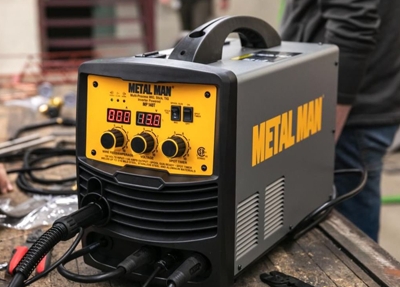Can I Run My Welder on Household Power?
Many welders available can run off standard 115V or 120V household power. But how do you know if your home’s wiring is capable of doing this safely? And can you still get the best quality welds?
 Gone are the days of large tombstone welders that need special wiring to make quality welds. The key is making sure you have a circuit that can handle the amount of power that a welder needs.
Gone are the days of large tombstone welders that need special wiring to make quality welds. The key is making sure you have a circuit that can handle the amount of power that a welder needs.
Today, it’s common for 120V circuits to come with a 20A breaker in your breaker box. That was not always the case, though. If you have an older home, you may find that your circuit breakers are 15A. In fact, depending on how old the wiring in your home is, you may even see fuses as low as 10A. Before you buy a welder, double check your electrical box to be certain your line provides 120 volt, 20 amps of service.
Input power is the power that needs to be inputted into an electrical device for that device to work properly. It’s a combination of voltage and amperage. Sometimes you’ll hear it stated in wattage. This is common in generators.
Wattage is the input voltage (120 volts) multiplied by the input amperage draw (20 amps).
Input volts x Input Amperage Draw = Wattage needed
(120 volts x 20 Amps = 2400 watts)
Typical household items and the input power requirements:
Hair Dryer = 120V, 16 Amps
Toaster = 120V, 10 Amps
Microwave Oven = 120V, 13 Amps
Refrigerator = 120V, 7 Amps
A typical household circuit in new construction today is 120V and has a 20 Amp breaker. That means that the wiring in the walls of your home is sized to handle 20 amps. When more than 20 amps are being drawn, the wiring is not designed to handle that load. As a result, the breaker in the electrical box will “blow,” which protects the house. You may have experienced this yourself some morning when brewing coffee while running the microwave and the toaster at the same time.
Your typical 120V welder demands a fair amount of power. Afterall, you are melting metal! If you look at the specification information on most 120V welders, it will show that they operate off 120V power and have a max amp draw of 20 Amps.
This means that you need a dedicated 120V circuit to run a typical 120V welder. If you’re running off a circuit that has a refrigerator already drawing 7 amps, it’s likely that your welder will draw too much power. The resulting: your circuit breaker will blow to protect your home wiring.
Always contact a professional electrician when running a dedicated circuit. Dedicated means that no other items are plugged into that circuit. If there is anything else pulling power from the same circuit, it’s likely your circuit breaker will do its job and “blow” to protect your home.
You may be tempted to use an extension cord to extend the reach of your welder. Done right, an extension cord is a good temporary solution. It should never be considered a long-term solution for your welder.
Much like the wiring in your house, you need to consider the voltage and the amperage required to operate the welder. The packaging that comes with your extension cord when you buy it will explain what the voltage and amperage capacity is. A 120 volt, 20 amp extension cord that is 10ft long will have different size wiring than a 120 volt, 20 amp extension cord that is 50 ft long. Be certain to read the packaging to make certain you are buying a 20A cord. It is very unlikely that the extension cord you use for your Christmas lights will be capable of running a welder.
So, which Metal Man welders can you run on household power?
All these Metal Man welders work off 120 volt, 20 amp input power:
- Metal Man stick welders such as the ARC 80T Inverter DC Stick Welder.
- Flux core only wire welders such as the Flux Core 130i and the Flux Core 135T.
- Multi-process welders such as the MP-140T or the Multiprocess 141.
These Metal Man welders will work off of both 120V household power or 230V power:
- The Metal Man MIG 180DVT will allow you to MIG weld and flux core weld off both 120V or 230V power.
- The Metal Man Multiprocess 220iDV allows for MIG welding, Flux Core Welding, DC Stick Welding, and DC Scratch Start TIG welding off both 120V and 230V power.
If you have any questions about choosing the right welder for your needs, give us a call. We’re happy to help!

